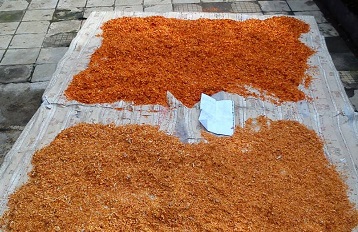A Group of IPB Students Created Extraction Technology for Sepang (Caesalpinia sappan L.)

The increased of free radical compounds in the air has become a global phenomenon. The population growth also leads to negative impacts on the environmental degradation. Overpopulation is an undesirable condition where the number of existing human population exceeds the carrying capacity of Earth. the effect of population growth along with the increase in urbanisation, increase the number of vehicles used. Vehicles produce significant amounts of air pollution that's harmful to human health an increased need for motor vehicle use. The increase in the number of motor vehicles leads to an increase in greenhouse gas emissions (GHG) which is the result of incomplete combustion so that the concentration of radical in the free air also participate increased. This is further exacerbated by the depletion of the ozone layer that triggers UV irradiance sunlight beyond the threshold so that the accumulation of free radicals is increasing. The accumulation of these harmful free radicals can lead to health threats to humans.
Free radical are highly reactive species, capable in the nucleus, and in the membranes of cells of damaging biologically relevant molecules such as DNA, proteins, carbohydrates, and lipids. Free radicals attack important macromolecules leading to cell damage and homeostatic disruption. The interplay between free radicals, antioxidants, and co-factors is important in maintaining health, aging and age-related diseases. Free radicals induce oxidative stress, which is balanced by the body’s endogenous antioxidant systems with an input from co-factors, and by the ingestion of exogenous antioxidants. If the damage is not too severe then it can still be repaired by a DNA repair system. However, a potentially dangerous type of DNA damage occurs when both strands of the double helix are broken, leaving no intact template strand for repair. If enough DNA damage builds up over time, it can cause cells to start growing out of control, which can lead to skin cancer. According to World Health Organization (WHO), it is estimated that in 2030 there will be an increase of cancer patients in Indonesia up to seven times. Based on the above conditions, a solution is needed to overcome the free radicals effectively and efficiently.
This apprehensive condition seems to attract the attention of some students of the Faculty of Agricultural Technology of Bogor Agricultural University (FATETA IPB) to apply for funding support from the Program Kreativitas Mahasiswa (PKM Student Creativity Program). Seeing the dangerous and threatening case of dangerous radicals, a group of students consist of Rafiq Izzudin Rabbani, Deli Situmorang, Irsyadul Ibad, Ilham Maulidin and Amar Muammar Qadafi, sought solutions through the discovery of antioxidants that could overcome free radicals. Anti-oxidants in the biological sense are all compounds that reduce and / or deactivate free radical attacks. One potential source of natural anti-oxidants is wood secang. Secang wood or sepang (Caesalpinia sappan L.) is more widely known by the public as a plant that can be used as a source of natural dyes, and its extract contains five active compounds of flavonoids that act as antioxidants. The extract had been proved to have cytotoxic and anti proliferative effect against several cancer cell lines. Scientifically those active compounds contain anti-oxidants, anti-bacterial, anti-inflammatory, anti-photoaging, lowering fat levels, relaxing blood vessels, protecting liver and anti-acne. Secang has been proven to possess anticancer activity on some cancer cell lines.
Beverages made of secang (Caesalpinia sappan L.) extract has been widely consumed by Indonesian people in the form of, especially in South Sulawesi because it is believed to increase the body resistance. However, in fact the benefits obtained by the community have not been utilized maximally as the extraction process, maceration and infusion, commonly practiced has many weaknesses. The main disadvantage of the maceration takes a relatively long time for completion, used quite a lot in micellar catalysis, and most likely some of the compounds are lost. Whereas for infusion method, they caused the damage of the content of the compounds present in secang.
Therefore, Rafiq Izzudin and his group offered a new method through cavitation technology. Cavitation technology is a new innovation method on environmentally friendly cell wall degradation techniques, the cost is relatively cheap and applicable for industry. Cavitation is the formation of vapour cavities in a liquid, that are the consequence of forces acting upon the liquid. It usually occurs when a liquid is subjected to rapid changes of pressure that cause the formation of cavities in the liquid where the pressure is relatively low. When subjected to higher pressure, the voids implode and can generate an intense shock wave. In the anti-oxidant extraction process of secang wood, cavitation technology is performed mechanically to degrade lignocellulose on secang wood through response to negative pressure given so as to facilitate solvent in dissolving anti oxidant. The negative pressure given causes the bubbles to form in the digester chamber. These bubbles will break down the lignin when interacting at certain pressures. Therefore, the cavitation method is chosen as the most appropriate method in extracting secang wood so that the characteristic of antioxidant rendement is maximally obtained. (Wied)



